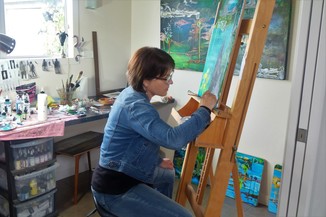lea-anne sheather

Lea-Anne Sheather acquired her Master’s degree with First Class Honours from Whitecliffe School of Fine Arts. She was the winner of The Miles Art Award in 2014 and her work is held in significant collections including Chris Parkin and Sir James Wallace Arts Trust.
Lea-Anne Sheather’s work is driven by what the philosopher Lev Shestov described as a “God-craziness... which requires a turn towards Earth…to love the world in its flux and immutability and to be crazy in love with the world of life, to engage ourselves in its power, resilience, connectivity and ambiguity”.
Sheather seeks to reflect the wonder and allure of nature through the shamanic-like creatures that she has been working on and developing over a few years and the imaginary place they were created in which she calls 'The Island of Woo’. She describes the creatures as being like little spirits that The Island of Woo has given birth to. The Island of Woo is also under its own construction too. It evolves, breathes, and transforms as much as the shamanic creatures it has made.
Sheather describes the Island of Woo as being like a ruin. It is similar in that a ruin reminds us of the temporary nature of our existence. The inherent beauty within nature slowly erases the wound that is the ruin and demonstrate that time is unstoppable. For 4 billion years life has been continuous on Earth. Humans materialised in a dynamic relationship with all other life forms. We shared water, air, and energy. However, we are now in the precarious position where we are unmaking the world of life that has been in the making for so long.
This has come about from the continual exploitation of our natural resources. Our evolutionary kinship is forgotten, unacknowledged and disrespected. The interruption that is created with man-made mass deaths within the natural world means that the future complex richness of life is being eroded and evolution is disturbed. Extensive, slow and comparatively unseen devastations are now the homeland of our existence. This catastrophe represents our ruin.
BIOGRAPHY
Education: Master of Fine Arts with1st Class Honours (2014)
Public Exhibitions: Arts Revealed: Whakatane Art Gallery (2016), The Supremes: Tauranga Public Art Gallery (2015), Scapes: Whakatane Museum Gallery (2015), Glaistor Ennor Graduate Art Award, Sanderson, Auckland (2014), Ruins: Artspost, Hamilton (2014)
Awards- Miles Art Award Supreme Winner (2014), Glaistor Ennor Graduate Art Award Finalist (2014), Parkin Drawing Award Finalist (2016 & 2013), Rotorua Art Award Finalist (2017 & 2015), Molly Morpeth Local Artsist Art Award finalist and winner.
Artwork featured in:
Batt, Tanya, Imagined Worlds, Playcentre Publications, 2001
Hourigan, H & Cooper, A, Arts Revealed: Eastern Bay of Plenty, 2016
Viva La Vita magazine, 2017
Lea-Anne Sheather’s work is driven by what the philosopher Lev Shestov described as a “God-craziness... which requires a turn towards Earth…to love the world in its flux and immutability and to be crazy in love with the world of life, to engage ourselves in its power, resilience, connectivity and ambiguity”.
Sheather seeks to reflect the wonder and allure of nature through the shamanic-like creatures that she has been working on and developing over a few years and the imaginary place they were created in which she calls 'The Island of Woo’. She describes the creatures as being like little spirits that The Island of Woo has given birth to. The Island of Woo is also under its own construction too. It evolves, breathes, and transforms as much as the shamanic creatures it has made.
Sheather describes the Island of Woo as being like a ruin. It is similar in that a ruin reminds us of the temporary nature of our existence. The inherent beauty within nature slowly erases the wound that is the ruin and demonstrate that time is unstoppable. For 4 billion years life has been continuous on Earth. Humans materialised in a dynamic relationship with all other life forms. We shared water, air, and energy. However, we are now in the precarious position where we are unmaking the world of life that has been in the making for so long.
This has come about from the continual exploitation of our natural resources. Our evolutionary kinship is forgotten, unacknowledged and disrespected. The interruption that is created with man-made mass deaths within the natural world means that the future complex richness of life is being eroded and evolution is disturbed. Extensive, slow and comparatively unseen devastations are now the homeland of our existence. This catastrophe represents our ruin.
BIOGRAPHY
Education: Master of Fine Arts with1st Class Honours (2014)
Public Exhibitions: Arts Revealed: Whakatane Art Gallery (2016), The Supremes: Tauranga Public Art Gallery (2015), Scapes: Whakatane Museum Gallery (2015), Glaistor Ennor Graduate Art Award, Sanderson, Auckland (2014), Ruins: Artspost, Hamilton (2014)
Awards- Miles Art Award Supreme Winner (2014), Glaistor Ennor Graduate Art Award Finalist (2014), Parkin Drawing Award Finalist (2016 & 2013), Rotorua Art Award Finalist (2017 & 2015), Molly Morpeth Local Artsist Art Award finalist and winner.
Artwork featured in:
Batt, Tanya, Imagined Worlds, Playcentre Publications, 2001
Hourigan, H & Cooper, A, Arts Revealed: Eastern Bay of Plenty, 2016
Viva La Vita magazine, 2017
